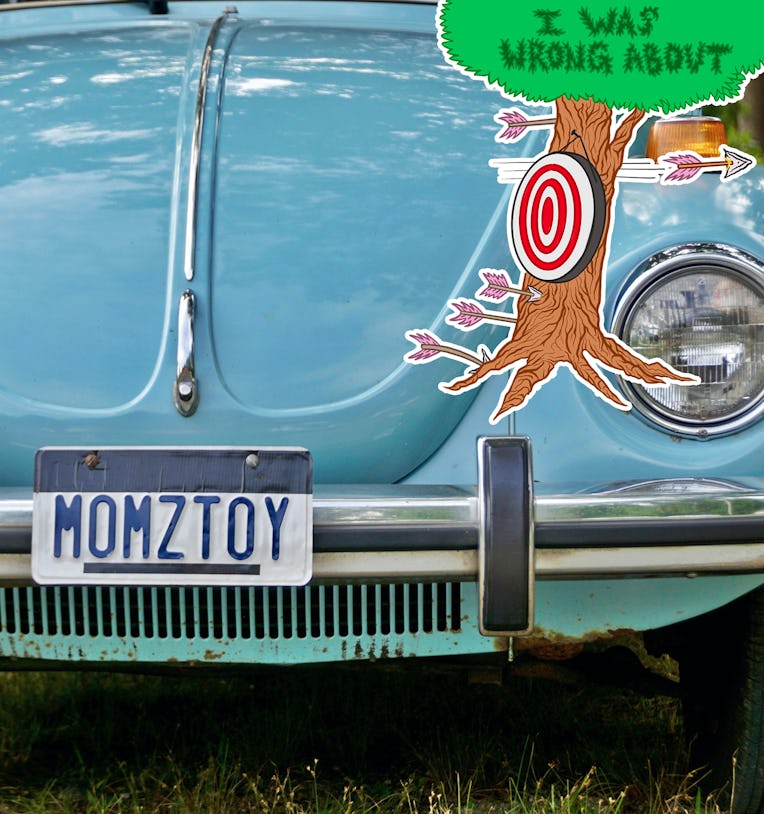Welcome to I Was Wrong About, a series of reconsiderations and mea culpas.
For years, I was of the mindset that vanity license plates were inherently bad objects. Their lack of virtue is right there in the name. We teach children that vanity is bad, that they should stop preening in the mirror and, by extension, that they should accept their lot in life and make do with the random combination of numbers and letters granted to them by the powers that be (local government agencies). Why then, I questioned, do we allow anyone to partake in this harmless yet aggressively frivolous manifestation of consumerism-meets-special snowflake syndrome, to take pride in the fact that they can throw down $50 a year on a low-rent status symbol declaring themselves a KOOLM0M or DOGDAD?
Yet as an adult, I’ve come to the realization that, actually, vanity plates are a great source of comedy. This change of tune is unexpected, since, as a resident of a large city with great transit, I’ve otherwise become firmly anti-car. Urban automobiles are the embodiment of toxic individualism: noise pollution machines that take up too much space and kill too many people, just so a driver can get somewhere five minutes faster than if they took the subway. Their incessant honking drives everyone mad, their doors fling cyclists into the path of traffic, and their steering wheels can steer the metal monsters right into pedestrians — but the license plate does none of this. Vanity plates may be the only truly innocuous part of the car, and the only part with potential for humor.
The catalyst for my vanity plate epiphany was the Instagram account @quebplates. It documents vanity plates in the Canadian province of Quebec, with a focus on plates that are dark, silly, pop cultural, or puerile. The page has documented plates that read “4LOKO,” “THIRSTI,” “VANGINA,” and a real-life iteration of Arrested Development’s “ANUSTRT” (and this is just scratching the surface). Frankly, the people behind these plates deserve credit: Like writing a seven-character tweet, it’s very hard to convey a coherent message within the spatial limits of a license plate. And yet plates like “H82 PEE” or “911WTC7” manage to stretch the creative bounds of human language to construct an entire micro-narrative about the car’s owner. What kind of person would pay for a plate that says “BRALESS” or “XAMAX”? Are they a hippie-adjacent bra burner? A big ol’ benzo fan? Done right, vanity plates tickle the brain, providing a welcome distraction that invites speculation and daydreaming.
Tragically, there is one big impediment to these plate-based antics: censorship. Few North Americans can experience the mirth of spotting a plate that says “DIGBICK” or “FARTMAN” because many DMVs have a deep-seated censorious streak and disregard for the freedom to make silly but ultimately harmless anatomy jokes. North Carolina, for example, has a list of over 7,000 banned plates. Are you a woman seeking to express your love of other women? Too bad: “LESBIAN,” “LESB1AN,” and “LESBIE” are all banned under this draconian regime. Are you an astronomy hobbyist with a predilection for gas giants? You’re out of luck, since the Tar Heel state won’t print you a “URANUS” license plate.
The list does have a number of plates that probably should stay out of public view — mostly variations on racist or homophobic hate speech. But for every “YTPRIDE” plate that merits a ban, there’s an equal number that seem to be banned for no reason whatsoever, like “FAERIE,” “DENVER B,” or “SHEIK.” And this isn’t some kind of Southern conservative anomaly: California may be even more heavy handed, banning the innocent “BEMYBAE,” since “bae” means “poop” in Danish.
This freedom-hating approach to vanity plates doesn’t just kill the fun; it’s also a waste of tax dollars. California’s DMV went to court to fight for its right to stop vehicle owners from putting “GASPASR” on their plates (the DMV lost). In a similar case in Rhode Island, put forward by the ACLU, the state was forced to admit plates like “FATTY” and “DRUNK.” Sadly, over in freedom-phobic Canada, a man named Dave Assman lost his appeal to put his last name on his plates.
Mercifully, there are jurisdictions that are open to plate-based shenanigans. While Quebec reserves the right to veto “obscene, scandalous, or sexual” plates, the treasure trove of @quebplates indicates that they wield this power sparingly; the same applies in Maine, where you can express gratitude via a “THXBTCH” plate without getting pinched by the lobster-esque arms of the state government.
Anyone who claims to love freedom and self-expression should hold places like Maine and Quebec in high esteem for this. Vanity plates are fun, and the more they invoke bowel movements, squirting, and the numbers 69 and 420, the more fun they become. It’s accessible comedy, too; everybody can giggle at a car that says “PENIS.” Sure, some parents may be upset at the prospect of explaining a “WAN2CUM” license plate to their kid out in the wild. To them, I offer this comfort: If your kid is young or naive enough to believe in Santa, you can probably get away with telling them that the plate is about wanting to come to a party.
And to any government officials reading, I say: Free the plates. If we've fully signed over our streets to deadly, moving, two-ton metal boxes, then at least I should be able to let my vehicle identify me as an “ASSCL0WN.”
Tim Forster is a freelance food, culture and tech writer/editor, based in Berlin, Germany.
